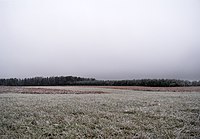
Photo from wikipedia
Three-dimensional large eddy simulations (LES) are used to analyze a springtime Arctic mixed-phase stratocumulus observed on 26 April 2008 during the Indirect and Semi-Direct Aerosol Campaign (ISDAC). Two subgrid-scale turbulence… Click to show full abstract
Three-dimensional large eddy simulations (LES) are used to analyze a springtime Arctic mixed-phase stratocumulus observed on 26 April 2008 during the Indirect and Semi-Direct Aerosol Campaign (ISDAC). Two subgrid-scale turbulence parameterizations are compared. The first scheme is a 1.5-order turbulent kinetic energy (1.5-TKE) parameterization that has been previously applied to boundary layer cloud simulations. The second scheme, Cloud Layers Unified By Binormals (CLUBB), provides higher-order turbulent closure with scale-awareness. The simulations, in comparisons with observations, show that both schemes produce the liquid profiles within measurement variability, but underpredict ice water mass and overpredict ice number concentration. The simulation using CLUBB underpredicted liquid water path more than the simulation using the 1.5-TKE scheme, so the turbulent length scale and horizontal grid box size were increased to increase liquid water path and reduce dissipative energy. The LES simulations show this stratocumulus cloud to maintain a closed cellular structure, similar to observations. The updraft and downdraft cores self-organize into a larger meso-γ scale convective pattern with the 1.5-TKE scheme, but the cores remain more isotropic with the CLUBB scheme. Additionally, the cores are often composed of liquid and ice instead of exclusively containing one or the other. These results provide insight into traditionally unresolved and unmeasurable aspects of an Arctic mixed-phase cloud. From analysis, this cloud's updraft and downdraft cores appear smaller than other closed-cell stratocumulus such as midlatitude stratocumulus and Arctic autumnal mixed-phase stratocumulus due to the weaker downdrafts and lower precipitation rates.
Journal Title: Journal of Geophysical Research
Year Published: 2017
Link to full text (if available)
Share on Social Media: Sign Up to like & get
recommendations!